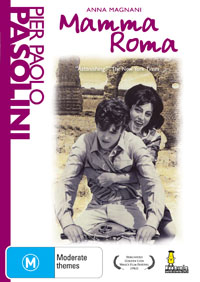Mamma Roma (1962) |
|
Mamma Roma (1962) |
|


|
| BUY IT |
| General | Extras | ||
| Category | Drama |
Audio Commentary-by Andrea Rizzi, Lecturer in Italian, University of Melb. Featurette-Via Pasolini - a documentary Trailer-Rocco and his Brothers Trailer-The Bicycle Thief |
|
| Rating |

|
||
| Year Of Production | 1962 | ||
| Running Time | 106:27 | ||
| RSDL / Flipper | RSDL (76:32) | Cast & Crew | |
| Start Up | Ads Then Menu | ||
| Region Coding | 4 | Directed By | Pier Paolo Pasolini |
|
Studio
Distributor |
 Umbrella Entertainment |
Starring |
Anna Magnani Ettore Garofolo Franco Citti Silvana Corsini Luisa Loiano Paolo Volponi Luciano Gonini Vittorio La Paglia Piero Morgia Lanfranco Ceccarelli Marcello Sorrentino Sandro Meschino Franco Tovo |
| Case | Amaray-Transparent-S/C-Dual | ||
| RPI | $29.95 | Music | Antonio Vivaldi |
| Video | Audio | ||
| Pan & Scan/Full Frame | Unknown |
Italian Dolby Digital 1.0 (192Kb/s) English Audio Commentary Dolby Digital 2.0 (224Kb/s) |
|
| Widescreen Aspect Ratio | 1.85:1 | ||
| 16x9 Enhancement |
 |
||
| Video Format | 576i (PAL) | ||
| Original Aspect Ratio | 1.85:1 | Miscellaneous | |
| Jacket Pictures | No | ||
| Subtitles | English | Smoking | No |
| Annoying Product Placement | No | ||
| Action In or After Credits | No | ||
Pier Paolo Pasolini is often referred to as one of the most controversial film directors of all time due to his confronting cinematic style. Mamma Roma, for example, was initially banned in many countries due to offensive language, it was not shown in the United States until 1995. Pasolini's most famous film, Salo, made in 1975 and Pasolini's last film before his death, is still banned in Australia. As recently as 2008 the distributor of this film wanted to classify Salo for distribution and it was refused classification. Although Mamma Roma is nowhere near as confronting as Salo, what is it about Pasolini's style that has been so confronting to audiences? The answer to this question lies in Pasolini's background.
Pasolini was a poet before he was a filmmaker. He was a man of contrast, he loathed his father and adored his mother, he was a strict Marxist who hated and despised fascism and the political suppression of rights for the lower classes of society, he was a critic of the authoritarian structure of the Catholic Church, yet still was able to make one of the greatest films on the life of Christ, The Gospel according to St. Matthew (by presenting Christ as a revolutionary and opposer of corrupt authority). Pasolini was a great intellect, a writer who collaborated on Federico Fellini's great works , The Nights of Cabiria and La Dolce Vita. He sought to bring to his films a metaphoric undertone that was prevalent in his writings. Thus, when he made films that presented confronting themes and images, this was a reflection of his political and philosophical expression meant to inspire and induce a cultural change in the lives of his audience.
Mamma Roma reflects the metaphoric symbolism of Pasolini's intellectual style. Anna Magnani plays Mamma Roma, a former prostitute who struggles to give her son Ettore (Ettore Garofolo) a better life than she had. She aims to work hard and inspire Ettore to get a good job, unfortunately Ettore is unable to distinguish the influence of his peers and falls into the same aimless way of life of his generation, reliant upon crime to get by and not valuing the emotional and financial commitment of his mother. When Mamma Roma's former pimp, Carmine (Franco Citti) returns to encourage her to return to her former way of life, he threatens to tell her son about her past.
The characters of the film thus signify the political and social changes that Italy was experiencing after World War II. Carmine represents the fascist era of pre-World War II, Mamma Roma represents the generation that experienced repression and economic hardship and seeks to be independent and have a better life, while Ettore represent the youth of post World War II Italy who were materialistic and spiritually empty. When one sees the film this way (SPOILER ALERT: highlight with mouse to read) it makes the death scene of Ettore easier to comprehend at the end of the film, as well as Mamma Roma's reaction to threaten suicide in the final scene when she is staring at the dome of St Peter's Basilica. She can't escape the influence of her past and it is God's hand that has intervened to show her the truth of this fact.
The transfer is the same one used as the Region 1 Criterion release. The film has been re-mastered from the restored original negative. The restoration effort was a collaboration between Gruppo Mediaset and Il Centro Sperimentale per la Cinematografia Cineteca Nazionale.
The aspect ratio is 1:85:1, however the transfer is slightly picture boxed on all sides, this would not be noticeable on most televisions.
The re-mastered image contains no film grain so the film looks superb, although there are minor artefacts throughout the film.
The cinematographer, Tonino Delli Colli worked together with Pasolini to boost the contrast of certain scenes, this was a deliberate creative decision to highlight the black-and-white presentation of the film.
There are no compression issues on this transfer, the film takes up 5.2 gb of a total of 7.5 gb on a dual-layer disc. The average bitrate is above average for a DVD at 6.70 mb/sec. As mentioned briefly before, issues with this transfer are minimal. There is telecine wobble during the first 2 minutes of the film and again at 30:18 and 43:08. Black lines appear briefly at 3:21, 3:24 and 6:42. White film artefacts are present at 5:23, 8:24, 10:17, 65:18, 68:16, 69:20, 70:04 and 71:44. Black film artefacts are present briefly at 52:54, 68:38, 77:26 and 79:43.
The subtitles are in a soft, white font and easy to discern. They are also user-friendly as they are optional.
RSDL change occurs at 76:32 during a fade-to-black scene change.
| Sharpness | |
| Shadow Detail | |
| Colour | |
| Grain/Pixelization | |
| Film-To-Video Artefacts | |
| Film Artefacts | |
| Overall |
The film does not contain live audio recording, the actors had their dialogue dubbed in later as was the custom of Italian films during the period that the movie was shot.
The main audio track is presented in Italian. It is a Dolby Digital mono track encoded at 192 kbps. The commentary track is in English. It is a Dolby Digital 2.0 track encoded at 224 kbps, although essentially it is mono also.
There are some audio sync issues due to the post dubbing done on the audio track, the effect is hardly noticeable though the longer you view the film.
"Concerto in D Minor" by Vivaldi is played at various points of the film and somehow it doesn't seem to fit into the neo-realist nature of the film, I believe that Pasolini did this to add dramatic effect to some scenes.
There is no Surround Channel Usage as the audio track is mono.
The Subwoofer is not utilised for this feature.
| Dialogue | |
| Audio Sync | |
| Clicks/Pops/Dropouts | |
| Surround Channel Use | |
| Subwoofer | |
| Overall |
NOTE: To view non-R4 releases, your equipment needs to be multi-zone compatible and usually also NTSC compatible.
The film has been released in three different regions, Region 2 in French, Region 1 and Region 4.
The Region 2 release is not 16x9 enhanced for widescreen televisions and contains no extras.
The Region 1 Criterion release is from the U.S. It contains the same transfer as the Region 4, although extras are more extensive. It contains the following:
* Three new interviews about director Pier Paolo Pasolini, featuring Bernardo Bertolucci, an assistant director to Pasolini on Accattone; Tonino Delli Colli, cinematographer on eleven of Pasolini’s fourteen films; and Enzo Siciliano, author of Pasolini: A Biography.
* Pier Paolo Pasolini (1995), a 58-minute documentary by filmmaker Ivo Barnaḅ Micheli covering the career of the controversial artist.
* La ricotta (1963), a 35-minute film by Pasolini starring Orson Welles as a director who sets out to make a film about the Passion of Jesus.
* Original theatrical trailer.
* Poster gallery.
* A 32-page booklet featuring excerpted interviews with Pasolini on Mamma Roma and La ricotta, and essays by novelist and culture critic Gary Indiana and Pasolini biographer Enzo Siciliano.
The Region 4 release contains an expert audio commentary by Andrea Rizzi.
If you prefer the extras of the Criterion release, you would settle for that, otherwise, I am content with the same transfer for the Region 4 release with the bonus of the audio commentary that is not present on the Region 1 Criterion release.
One of Pier Pablo Pasolini's three master works, together with The Gospel according to St.Matthew and Salo, Mamma Roma signifies a change in the neo-realism theme present in Italian films of this era. After this film Pasolini's works were more personal. An appreciation of the social and political changes of the period set in the film will help the viewer to understand the meaning of the film. The exclusive audio commentary by Andrea Rizzi for this release is a beneficial addition to gaining an insight into the metaphorical and philosophical undertones of the film.
| Video | |
| Audio | |
| Extras | |
| Plot | |
| Overall |
| Review Equipment | |
| DVD | Sony BDP-S550, using HDMI output |
| Display | Samsung LA46A650 46 Inch LCD TV Series 6 FullHD 1080P 100Hz. Calibrated with THX Optimizer. This display device is 16x9 capable. |
| Audio Decoder | Sony STR-K1000P. Calibrated with THX Optimizer. |
| Amplification | Sony HTDDW1000 |
| Speakers | Sony 6.2 Surround (Left, Front, Right, Surround Left, Surround Back, Surround Right, 2 subwoofers) |